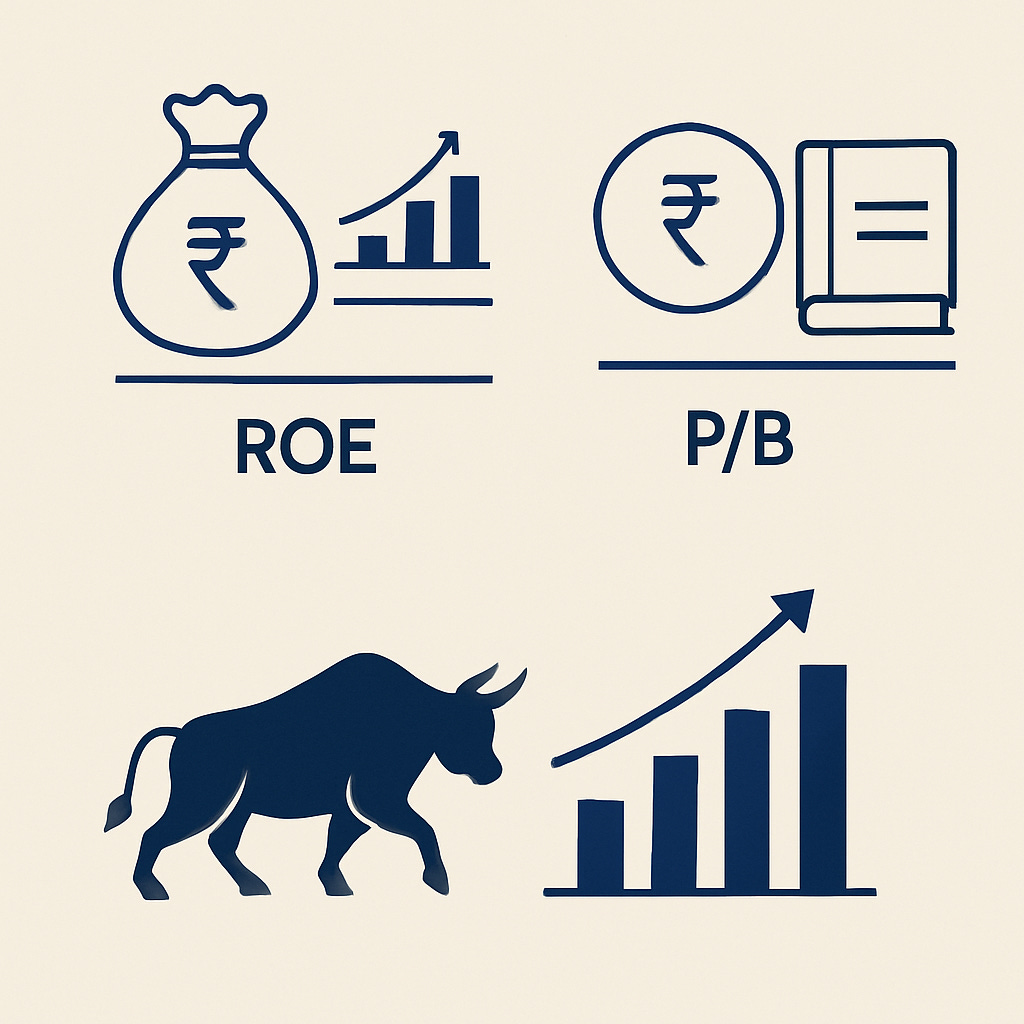How to Value a Stock: A Simple Guide to ROE and P/B
#Issue 24 Understand what makes a stock expensive or cheap — and how to spot real opportunities without overthinking
1. The Golden Rule of Investing: Capital Should Earn Returns
When you invest in a company, you are essentially giving it money (capital) to generate profits. The better a company uses your capital, the more valuable it becomes.
This is measured by a key metric called Return on Equity (ROE).
ROE = Net Profit ÷ Net Worth (Equity)
If a company earns 15% ROE, it means it generates ₹15 profit for every ₹100 of its equity. Higher ROE means more efficient use of capital and often leads to higher stock valuations.
Historically, the average ROE of Sensex companies has been around 15%.
2. ROE Drives Valuation — Understanding the Price-to-Book (P/B) Ratio
P/B = Market Price per Share ÷ Book Value per Share
(Book value = Company’s net worth = Total assets – liabilities)
P/B tells you how much you’re paying for each ₹1 of the company’s net worth.
If a business earns 15% ROE, investors are typically willing to pay around 3 times its book value because the company is generating returns much higher than a 10-year government bond (6–7%).
Example Comparison:
3. Market Valuation Today
The Indian market typically trades between 2 to 4 times P/B.
At 2x P/B: The market is cheap — usually during periods of panic or crisis.
At 4x P/B: The market is expensive — returns may be muted.
As of 2025, the market is closer to 4x P/B. This is on the expensive side, so forward return expectations should be moderate.
4. Different Business Types, Different Valuation Rules
A) Cyclical Companies (e.g., Hindalco, Tata Steel)
Their ROE changes with the economic cycle. In a downturn, ROE can fall to zero or negative, and stocks can trade below book value. In an upcycle, they may trade at 2–3x book.
Smart investors buy when ROE is low and stocks are trading below book, and exit when ROE rebounds.
Example: Hindalco traded at 0.3x book in 2016 and 2–3x by 2021 — an 8x return for patient investors.
B) Defensive, Brand-Driven Companies (e.g., Nestle, Pidilite)
These businesses have strong brands, low capital needs, and consistently high ROE. Investors pay a premium — sometimes as high as 60–70x book — because the business is predictable and profitable.
C) High-Growth Transformations (e.g., Bajaj Finance)
Bajaj Finance started as a low-ROE business (4–5%), but after a model overhaul, its ROE jumped to 20%+. Valuation followed — from 0.5x to over 6x P/B — and profits compounded rapidly.
D) Tech and Quick Commerce (e.g., Zomato, Blinkit)
These companies are often loss-making today, but investors hope for future profits through scale and network effects. They are highly volatile, but can be big winners once profitability kicks in.
5. Sector-Specific Valuation Benchmarks
6. What to Look for: Good Businesses Going Through a Bad Time
When a quality company temporarily underperforms, its ROE and P/B drop. If the long-term fundamentals are intact, these situations often present buying opportunities.
Example:
Lupin’s ROE fell below 10%, and it traded under 2x P/B. For a pharma company typically earning 15–20% ROE and trading at 3–4x P/B, that could be an attractive entry point.
7. Mutual Funds vs. Direct Stocks
Even basic tools like Screener.in can help you assess ROE and P/B trends.
8. Time Reduces Risk
Markets can be very volatile over 1 year (30% swings), but over 5+ years, risk reduces and returns become more predictable.
Most mutual funds haven’t delivered negative returns in any 5-year rolling period. Time is your best risk-management tool.
9. The Power of Compounding
Wealth builds when you:
Start early
Stay invested
Avoid unnecessary trades
Trying to “time” the market rarely works. Long-term holding of quality companies or funds delivers better results.
10. Spotting a Future Multi-bagger
Look for companies with:
Strong network effects (like Jio or Bharti)
High ROE and free cash flows
Ability to reinvest profits in new growth areas
These companies don’t just grow — they compound.
My Thoughts
You don’t need to be an expert to invest wisely. Start by understanding two key concepts: ROE and P/B.
From there, ask:
Is this company using capital efficiently?
Is the stock cheap or expensive relative to its book value?
Can this business grow, and for how long?
Investing is not about prediction — it’s about preparation, patience, and perspective.
Start simple. Stay consistent. Let time and compounding do the heavy lifting.
Disclaimer: This post is intended solely for informational and educational purposes. It does not constitute a recommendation to buy, sell, or hold any security. The views expressed are personal and based on publicly available information and past professional experiences. Please consult your financial advisor before making any investment decisions.







